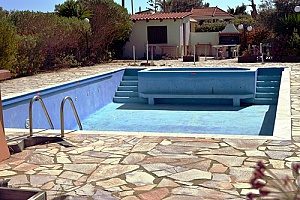 Pools are meant to be enjoyed all summer, but when winter begins they can often become a huge source of frustration. Pools require just as much care and maintenance during the winter as when they’re in use, and sometimes more depending on the average temperatures in your area. It’s natural to wonder whether it’s worth all the effort to maintain your pool. If you find yourself becoming increasingly irritated year after year, it may be worth considering pool removal services. A pool removal contractor can walk you through the removal process and help you decide whether this winter is the right time to bypass the stress of maintaining your pool for the colder months. Here are some of the issues you could avoid with professional pool removal services.
Pools are meant to be enjoyed all summer, but when winter begins they can often become a huge source of frustration. Pools require just as much care and maintenance during the winter as when they’re in use, and sometimes more depending on the average temperatures in your area. It’s natural to wonder whether it’s worth all the effort to maintain your pool. If you find yourself becoming increasingly irritated year after year, it may be worth considering pool removal services. A pool removal contractor can walk you through the removal process and help you decide whether this winter is the right time to bypass the stress of maintaining your pool for the colder months. Here are some of the issues you could avoid with professional pool removal services.
Plumbing Damage
Failing to properly care for your pool during the winter can lead to expensive plumbing and filtration damage. It’s important to pay close attention to the temperature, as freezing air temperatures can cause problems with pipes and filtration systems. To avoid these concerns, homeowners should keep their pool pumps running for several hours per day. This can run up electricity bills, so many pool professionals advise running the pumps late at night or early in the morning, when costs are lower. However, regularly remembering to run the pump at these hours can be difficult during the busy holiday season, and this forgetfulness could be costly.
Damage to Equipment
Frozen water can lead to serious problems with your equipment. Water left in the pump, pool heater, and filter can cause cracks throughout the equipment if it freezes. During the winter, it’s important to monitor the level of your pool water and keep it at four to six inches below the pool skimmer, which helps decrease the likelihood that frozen water will damage your equipment. These items can be expensive and time consuming to repair or replace, forcing you to wait longer before you’re able to use the pool again in the springtime.
Structural Damage
 Winter weather can also cause damage to your pool’s structure. Vinyl liners can tear, crack, or break thanks to frozen water within them. The water can then drain out, causing further damage to the liner and potentially flooding your backyard. If a pool cover falls into the draining pool, it can tear as well. Fixing the damage is difficult and can often not be repaired. Instead, the entire liner must be replaced, along with the bottom of the pool if your home is located in an area with a high water table. This can represent a high cost to homeowners, as replacing liners can cost thousands of dollars.
Winter weather can also cause damage to your pool’s structure. Vinyl liners can tear, crack, or break thanks to frozen water within them. The water can then drain out, causing further damage to the liner and potentially flooding your backyard. If a pool cover falls into the draining pool, it can tear as well. Fixing the damage is difficult and can often not be repaired. Instead, the entire liner must be replaced, along with the bottom of the pool if your home is located in an area with a high water table. This can represent a high cost to homeowners, as replacing liners can cost thousands of dollars.
Pool Closing Concerns
Properly closing your pool for the winter is a detailed process that can easily go wrong. Many homeowners make the simple mistake of forgoing their pool covers during the winter, opening the water up to debris and bacteria that could cause damage to the water and equipment. Those that do cover their pool are only halfway done, however. The cover must be kept clear of snow, leaves, and other heavy materials that can weigh it down and render it ineffective. Draining the pool to avoid maintenance, though a common idea,can cause more harm than good, leading to shrunken liners and structural damage.
Algal Blooms
Wind, rain, and debris blown in by winter storms can bring in bacteria that causes algal blooms within hours of entering your pool. Bad pool circulation, filtration, and sanitation can all create ideal conditions for algae to begin growing in your pool, particularly during the beginning of the winter before freezing temperatures set in. Algae is difficult to remove, and once it appears in your pool once, future outbreaks are common, as it can settle into tiles, plaster, and in filters and other equipment.
Continual Pool Maintenance
Just because the pool is not being used doesn’t mean that you can let it go. Continual maintenance is essential to your pool’s safety during the winter months. The pump should always be running when the air temperature is freezing, which will help prevent damage to the plumbing and filtration systems. Adding extra chlorination and chemicals may also be necessary to ensure that salt water systems are properly running. To prevent debris from falling in to the pool, homeowners should tightly cover their pools and check the cover on a regular basis to prevent leaves, bacteria, and other damaging items from falling in.
Benefits of Pool Removal Services
 Pool removal effectively saves homeowners money and time throughout the year. By removing your pool, you will stop spending time checking on equipment, cleaning the pool area, securing it safely, and monitoring the chemical balance in the water. Because pools often lead to higher homeowners’ insurance premiums, removing your pool can save money on more than just equipment and maintenance costs. This can also make it easier to sell the home later because prospective homeowners may appreciate the lower insurance costs.
Pool removal effectively saves homeowners money and time throughout the year. By removing your pool, you will stop spending time checking on equipment, cleaning the pool area, securing it safely, and monitoring the chemical balance in the water. Because pools often lead to higher homeowners’ insurance premiums, removing your pool can save money on more than just equipment and maintenance costs. This can also make it easier to sell the home later because prospective homeowners may appreciate the lower insurance costs.
In addition to the savings of removing a pool, homeowners can also regain space in their backyard. Removing the pool opens up areas for landscaping, installing a shed or gazebo, and even building and extension to your home’s living space, depending on the type of pool removal performed. The yard can immediately become more useful and require less maintenance, allowing you and your family to truly enjoy the backyard without worrying about a pool’s maintenance and safety.
Hiring a Pool Removal Contractor
Speak to a pool removal contractor for more information and to schedule your pool removal services. Dirt Connections has years of experience in conducting full and partial pool removal services and provides free service estimates to help homeowners choose the right services for their needs.








































